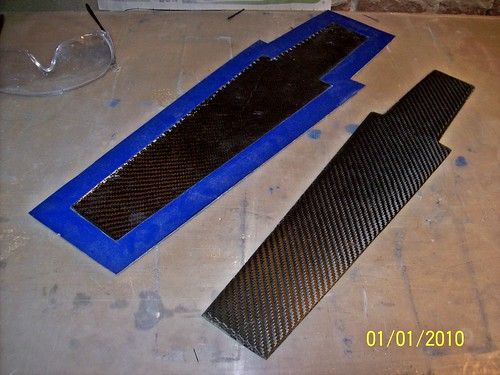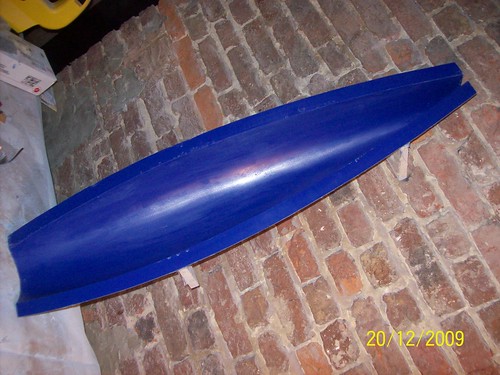Larry - The amount of work that goes into making a mold for a fin is only justified if you are intending to sell a bunch of them. In which case you will probably have to go with a two stage epoxy and either an oven or a heated mold with a rheostat to control heat gain. Things get much more complicated when customers get involved because they expect professional results when they pay for things like fins, even though they probably have no idea what goes into making them up to par, or why they are so expensive.
If you want to race your IOM then you would be better off buying the fin from a professional IOM builder, because you would get a product that is superior to anything a hobbyist could make. If you just want to tool around your pond and are not interested in competition then making your own one-off fin makes sense, both economically and to hone your building skills.
The method I would use is a sandwich of carbon fiber cloth and balsa. Choose the balsa thickness depending on the chord of the fin. Two sheets of balsa on either side of two layers of 6 oz. cloth. The balsa sheets should be cut roughly the profile of the fin, a little larger all the way around. The sandwich should be laid up with only enough resin to wet out the cloth and to cover the inner faces of the balsa sheets lightly, enough to sink in and give the surface of the balsa a light sheen. I wet out the cloth pieces separately on a piece of wax paper and apply them individually to the lower balsa sheet and top off with the other pre-wet balsa sheet. If you want to add a few strips of unidirectional carbon, wet them out and then apply them between the carbon cloth pieces. I clamp the sandwich between an inch thick plywood board and the bed of my tablesaw, but two straight boards would work too. The results should give you a fin blank without epoxy drips or epoxy smears on the balsa (which make it harder to shape). This blank also has the carbon as a convenient centerline to sand your chord to.
Skinning the fin is where my method varies a bit from what most people do. You can try to lay-up carbon cloth over your blank directly, but I’ve found this way to be messy and very hard to control. It also ends up with a heavy fin because you need to fill up the weave after it is cured. There is a lot of sanding involved to get a smooth finish and more than likely you will sand away some of the carbon, the stuff that gives your fin strength! I cast pre-curved skins in carbon that I attach to my faired fin blank. These pre-curved skins are laid up on the inner surface of a large planter (an old broken one from my container garden). The greater the diameter the better, my planter is 23 inches across the top and tapers just slightly. In spite of being used it has a very smooth interior surface (and without ridges, very important!). I’ve also used a sheet of tin, actually a length of straight tin ducting that I cut along its seam so that I could spread it a bit for a larger diameter. I’m sure that there are many ways to achieve the desired end, which is to have pre-curved skins to laminate onto the fin blank.
When I do the skin lay-up I usually use an outer layer of sheathing glass and an inner layer of 6 oz. cloth. The sheathing glass allows you to score trim lines onto the skins. These will show up as white against the black carbon cloth, making it much easier see where to cut the fin’s profiles. Once the skins are cut to the fin profile the inside faces of the skins should be roughed up with course sandpaper and cleaned of any dust before they can be laminated. Next the trailing edges of the skins are taped together. The taping should be done against a flat surface. I usually alternate sides as I tape along the edge. The critical part of this procedure is to make sure that the taped edge is dead straight. It is very easy to impart a curve or a scallop in the tape job and it may take a couple tries to get an acceptable trailing edge.
The skins should fit around the faired blank so that once the trailing edge of the skins is in place over the trailing edge of the blank the leading edge of the skins is just even with front end of the blank, or just past. You don’t want to overlap the leading edge of the blank because when the skins are laminated on they will be taped tightly together around the leading edge, too much skin in front of the blank and the tape can impart a buckle into the skins and cause a void between the skins and the blank (this will weaken the fin). If the fin is tapered then as the skins are laminated in place they will have to be taped over the top edge so the blank doesn’t start to slip out during the process.
After some practice fittings to make sure everything will work smoothly its time to laminate the skins in place. I would recommend that you start out with a straight trailing edge in your fin design. With a straight trailing edge the taped-together skins can be butterflyed open to apply epoxy to (much easier than getting resin into the cramped space of two skins partly pried apart). The blank is also wetted out, again apply only enough epoxy to form a thin film over all surfaces (there won’t be much if any absorbed, you don’t want a lot of epoxy oozing out all over the place). Carefully fold the taped skins over the blank making sure that the trailing edge of the blank is as far back as it can go without spreading the skins apart. Hold the blank in place with one hand and smooth the skins forward over the blank with the other. Have a paper towel handy to wipe away excess epoxy that may ooze out (you want a “dry” layup, just enough to attach the skins to the blank). Once the excess is wiped away start taping the leading edge closed (its a good idea to have lengths of tape pre-cut and handy). I usually start taping from the middle and work my way to each end, alternating directions as I go. Once the leading edge of the skins are taped up there should be a gap at the front between the skins (1/16th" to 3/32" is good). This gap will later be filled with epoxy thickened with graphite powder and faired to a nice blunted edge. The last step is to tape two straight pieces of wood to either side of the trailing edge of the fin’s skins. I apply pressure to these strips with light hand clamps. The idea here is to flatten out the aft section of the pre-curved skins (remember they are formed on the inside of a circular form and the fin should be some kind of airfoil). This will in turn push the skins forward a bit so make sure that the taped leading edge doesn’t distort the skins. If there is a problem you may need to re-tape in places to reduce the “closing” pressure.
I mask the outside of the skins before laminating just to make sure I don’t get any excess epoxy on the surface. In most cases the release agent residue will allow any spots of epoxy to be scraped off with a razor blade.
Rudders can be made the same way although the carbon center laminate is omitted. Actually, except for a center spline of balsa and a leading edge strip of balsa my rudders are hollow.
I hope this is clear. It will give you a light weight, strong, and cosmetically professional looking fin.

